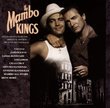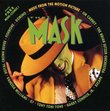| All Artists: Christopher Maltman, Gustav Mahler, Benjamin Zander, Boston Philharmonic Orchestra, Philharmonia Orchestra of London Title: Mahler: Symphony No. 1; Lieder eines fahrenden Gesellen Members Wishing: 0 Total Copies: 0 Label: Telarc Original Release Date: 1/1/2005 Re-Release Date: 10/25/2005 Genres: Special Interest, Pop, Classical Styles: Vocal Pop, Symphonies Number of Discs: 1 SwapaCD Credits: 1 UPC: 089408062827 |
Search - Christopher Maltman, Gustav Mahler, Benjamin Zander :: Mahler: Symphony No. 1; Lieder eines fahrenden Gesellen
 | Christopher Maltman, Gustav Mahler, Benjamin Zander Mahler: Symphony No. 1; Lieder eines fahrenden Gesellen Genres: Special Interest, Pop, Classical
|
CD DetailsSimilar CDs
Similarly Requested CDs
|
CD ReviewsA Mahleresque Mahler First! Grady Harp | Los Angeles, CA United States | 02/05/2006 (5 out of 5 stars) "Benjamin Zander continues his survey of the symphonies of Gustav Mahler with an all stops out performance of the 'Titan', Mahler's great first symphony, which has been less recorded in the past decade than most of his other symphonies. Zander obeys all of Mahler's score markings, which means that when Mahler calls for extremes in dynamics or manipulation of phrasing, Zander is right there with him. For some this may feel excessive and too blatantly showy, but then consider the fact that this was indeed the first work of a composer who dwelled on passion and eruptive emotions and the concept makes great sense. The Philharmonia Orchestra plays its heart out for him and the recorded sound displays this highly theatrical, and for this listener, successful approach. Zander couples this performance of the Titan with the 'Lieder eines fahrenden Gesellen', beautifully sung by Christopher Maltman. Again, Zander goes for the angst and the drama and at times the emotion seem overstated, but just examine Mahler's notes on his score and realize this is the way the master instructed the work to be performed. For a Mahler version of Mahler works, this CD is a breath of fresh air form the more transparent, underplayed, dignified approaches of some of the other fairly recent recordings. It is a pleasure to the senses. Highly Recommended. Grady Harp, February 06 " Music-making of the highest caliber Mike G. | Cincinnati, Ohio | 03/30/2006 (5 out of 5 stars) "Ironically, it takes a very mature musician/conductor to pull off a convincing performance of Mahler's most youthful symphony. When compared to later symphonies, the first has quite a large scope of musical material presented in such a short amount of space (Mahler tends to develop the same material more thoroughly in later works). The sheer amount of colors, styles and moods presented in this symphony may be daunting to even a trained professional. Most performances fall apart musically because conductors either fail to highlight details, lose scope of larger structures, or both. I think Zander strikes a perfect balance between details and structure. His interpretation, more so than others', successfully integrates all of Mahler's singular ideas into a whole, making complete sense from start to finish. There is a very clear sense of flow, of one idea generating - and leading into - the next. After listening to this recording, I finally felt that Mahler's idea had come across convincingly - that I had been given the correct information, in a sense, or at least one version of the correct information.
Zander doesn't contrive anything in order to sell the emotional content of the symphony. Instead, he opts, as said before, to bring out the details written in the score, either by amplifying what is commonly observed, or by observing in the first place what usually isn't. Dynamic contrasts are much larger, for example. Zander observes oft-ignored distinctions between pp and ppp. Crescendos and decrescendos are more severe. Accents are more calculated. This observation of correct dynamics allows for even the densest of Mahler's polyphonic textures to be clarified. As usual, Zander has the violins sit across from one another, allowing for Mahler's antiphonal effects to come across, and also bringing the harmonies more to the fore. Mahler's metronome markings have often been subjected to severe distortions, something that always hastens a structural collapse. This is especially true for the first movement, which contains 8 of the 12 markings. Zander doesn't follow them exactly, but he adheres to them more closely than other conductors do, taking care to keep their proportions intact. Finally, Zander excels in bringing across Mahler's coloristic touches. The best examples of this are the middle sections of the second and third movements (the Klezmer band is especially rustic), both of which are aided by Zander's masterly application of rubato and flexibility of tempo. Of course, the technical and musical prowess required of an orchestra to pull off this symphony is daunting, but the Philharmonia Orchestra pulls off another flawless performance. The solo work is among the best I've ever heard, and their brass section could beat the pants off of Berlin's or Chicago's, any day. In no way am I'm I exaggerating this fact. The closing horn fanfare had me sweating with disbelief. I apologize for only touching briefly on the Songs of a Wayfarer. Christopher Maltman turns in a fine and bracing rendition, comparable to classic accounts from Fischer-Dieskau and others, as well as any modern renditions. Zander provides a balanced and colorful accompaniment, and he is very successful in presenting the symphony and the song cycle as kin, the way they should be. Telarc provides excellent clear sound and balance, and the normally priced CD is well worth the money. I recommend this recording without hesitation." |

 Track Listings (8) - Disc #1
Track Listings (8) - Disc #1













